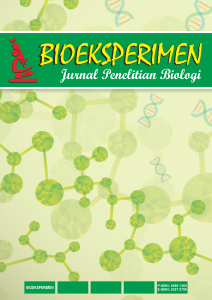Isolation, Characterization, and Identification of Biosurfactant-Production Bacteria from Used Cooking Oil Waste
DOI:
https://doi.org/10.23917/bioeksperimen.v11i2.11115Keywords:
biosurfactant, waste cooking oil, isolationAbstract
Waste cooking oil constitutes a significant environmental concern in Indonesia. It has the potential to be utilized as a substrate for biosurfactant-producing bacteria. Biosurfactants are amphiphilic compounds produced by microorganisms, containing both hydrophilic and hydrophobic components that enable them to dissolve in both water and fats, as well as to reduce surface tension. This study aims to isolate, characterize, and identify biosurfactant-producing bacteria from waste cooking oil. Isolation proccess was conducted using Mineral Salt Medium enriched with cooking oil as an inducer and Carboxy Methyl Cellulose as a carbon source and emulsifier. Two isolates were successfully obtained and purified. Their biosurfactant-producing ability was evaluated through drop collapse test and oil spreading test. One isolate demonstrated superior performance, showing positive activity in both tests, including a 0.7 cm oil spreading zone. Identification involved macroscopic observation, Gram staining, endospore staining, and a catalase test. The isolate exhibited characteristics of a Gram-positive, rod-shaped, spore-forming, catalase-positive bacterium with small, circular, milky-white colonies and a smooth surface. This identification is non-molecular and based on a phenotypic approach according to Bergey’s Manual for preliminary bacterial classification. Based on these features, the isolate is presumed to belong to the genus Bacillus, known for its robust biosurfactant production. The findings suggest that waste cooking oil can be a promising source of indigenous biosurfactant-producing bacteria, contributing to both microbial conservation and potential development of eco-friendly biotechnological products.
Downloads
References
Ambarsari, H., & Chen, H. Y. (2021). Isolasi Dan Seleksi Bakteria Penghasil Biosurfaktan Untuk Pengolahan Air Limbah. 123–132.
Amelia, N., & Titah, S. (2021). Kajian Pengaruh Penggunaan Biosurfaktan Rhamnolipida dan Surfaktin pada Proses Bioremediasi Tanah Tercemar Crude Oil. 10(2).
Chanif, I., Hambali, E., & Yani, M. (2017). Kinerja Oil Spill Dispersant Dalam Proses Bioremediasi Tanah Tercemar Minyak Bumi (Studi Kasus Tanah Tercemar Minyak Bumi Lapangan XYZ). Jurnal Teknologi Industri Pertanian, 27(3), 336–344. https://doi.org/10.24961/j.tek.ind.pert.2017.27.3.336
Chigede, N., Chikwambi, Z., Mpofu, I. D. T., & Madzimure, J. (2024). Isolation and characterization of biosurfactant-producing microbes isolated from the gastrointestinal system of broiler birds fed a commercial diet. Animal Biotechnology, 35(1). https://doi.org/10.1080/10495398.2023.2263771
Kharisma Swandi, M., Nurmiati Laboratorium Mikrobiologi, dan, Biologi, J., & Matematika dan Ilmu Pengetahuan Alam, F. (2015). Isolasi Bakteri Pendegradasi Limbah Cair Industri Minyak Sawit Isolation of Degrading Bacteria of Palm Oil Mill Effluent (POME). Jurnal Biologi Universitas Andalas (J. Bio. UA.), 4(1), 71–76.
Nguyen, M. T., Matsuo, M., Niemann, S., Herrmann, M., & Götz, F. (2020). Lipoproteins in Gram-Positive Bacteria: Abundance, Function, Fitness. Frontiers in Microbiology, 11(September), 1–15. https://doi.org/10.3389/fmicb.2020.582582
Olasanmi, I. O., & Thring, R. W. (2022). The role of biosurfactants in the continued drive for environmental sustainability. Sustainability (Switzerland), 10(12), 1–12. https://doi.org/10.3390/su10124817
Ray, M., Kumar, V., Banerjee, C., Gupta, P., Singh, S., & Singh, A. (2021). Investigation of biosurfactants produced by three indigenous bacterial strains, their growth kinetics and their anthracene and fluorene tolerance. Ecotoxicology and Environmental Safety, 208, 111621. https://doi.org/10.1016/j.ecoenv.2020.111621
Santos, D. K. F., Rufino, R. D., Luna, J. M., Santos, V. A., & Sarubbo, L. A. (2016). Biosurfactants: Multifunctional biomolecules of the 21st century. International Journal of Molecular Sciences, 17(3), 1–31. https://doi.org/10.3390/ijms17030401
Setlow, P., & Christie, G. (2023). New Thoughts on an Old Topic: Secrets of Bacterial Spore Resistance Slowly Being Revealed. Microbiology and Molecular Biology Reviews, 87(2), 1–21. https://doi.org/10.1128/mmbr.00080-22
Shaimerdenova, U., Kaiyrmanova, G., Lewandowska, W., Bartoszewicz, M., Swiecicka, I., & Yernazarova, A. (2024). Biosurfactant and biopolymer producing microorganisms from West Kazakhstan oilfield. Scientific Reports, 14(1), 1–15. https://doi.org/10.1038/s41598-024-52906-7
Shokouhfard, M., Kasra Kermanshahi, R., Vahedi Shahandashti, R., Feizabadi, M. M., & Teimourian, S. (2015). The inhibitory effect of a Lactobacillus acidophilus derived biosurfactant on Serratia marcescens biofilm formation. Iranian Journal of Basic Medical Sciences, 18(10), 1001–1007.
Thomas, S., Joshy, G., & Subbiah, K. (2022). Optimization of Biosurfactant Production using Chrysene Degrading Bacteria Isolated from Marine Water. Journal of Pure and Applied Microbiology, 16(4), 2580–2591. https://doi.org/10.22207/JPAM.16.4.25
Varjani, S. J., & Upasani, V. N. (2017). A new look on factors affecting microbial degradation of petroleum hydrocarbon pollutants. International Biodeterioration and Biodegradation, 120, 71–83. https://doi.org/10.1016/j.ibiod.2017.02.006
Zia, K. Z., & Linda, T. M. (2023). Potensi Bacillus spp. Sebagai Penghasil Biosurfaktan untuk Pengolahan Limbah Minyak Pelumas. Biota : Jurnal Ilmiah Ilmu-Ilmu Hayati, 8(2), 69–78. https://doi.org/10.24002/biota.v8i2.6360.
Downloads
Submitted
Accepted
Published
Issue
Section
License
Copyright (c) 2025 Bioeksperimen: Jurnal Penelitian Biologi

This work is licensed under a Creative Commons Attribution-NonCommercial 4.0 International License.












